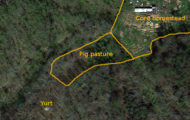Two days after hatching, our silkworms were growing
fast. No longer did they make tiny little holes in mulberry
leaves. Now they turned each meal into a skeleton, then wanted
more within a couple of hours.
I quickly learned that
silkworms will migrate to fresh leaves within minutes if you simply
place the old leaves on top of the new ones. As the silkworms get
older, we may have to start removing old leaves, but there currently
doesn’t seem to be any issue leaving them to dry up below the fresher
material.
Although none of the
instructions I read mentioned this, I’m glad I left the eggs in the
bottom of the bowl for the first couple of days because silkworms, like
chickens, don’t seem to hatch all at once. I estimated we had
about 100 sikworms by the end of day one, but then another big batch
hatched out and we ended up with perhaps 300 or more. It’s easy
to tell at a glance whether the majority of your eggs have hatched
since empty eggs are white instead of blue-gray.
As meal-time began to
encompass four or five leaves instead of one or two, I figured it was
time to move our silkworms to larger quarters. We’re trying them
out in a rubbermaid bin with sawdust on the bottom, just like they were
chicks. I’ll report in a later post whether that works out or if
we have to change gears.

